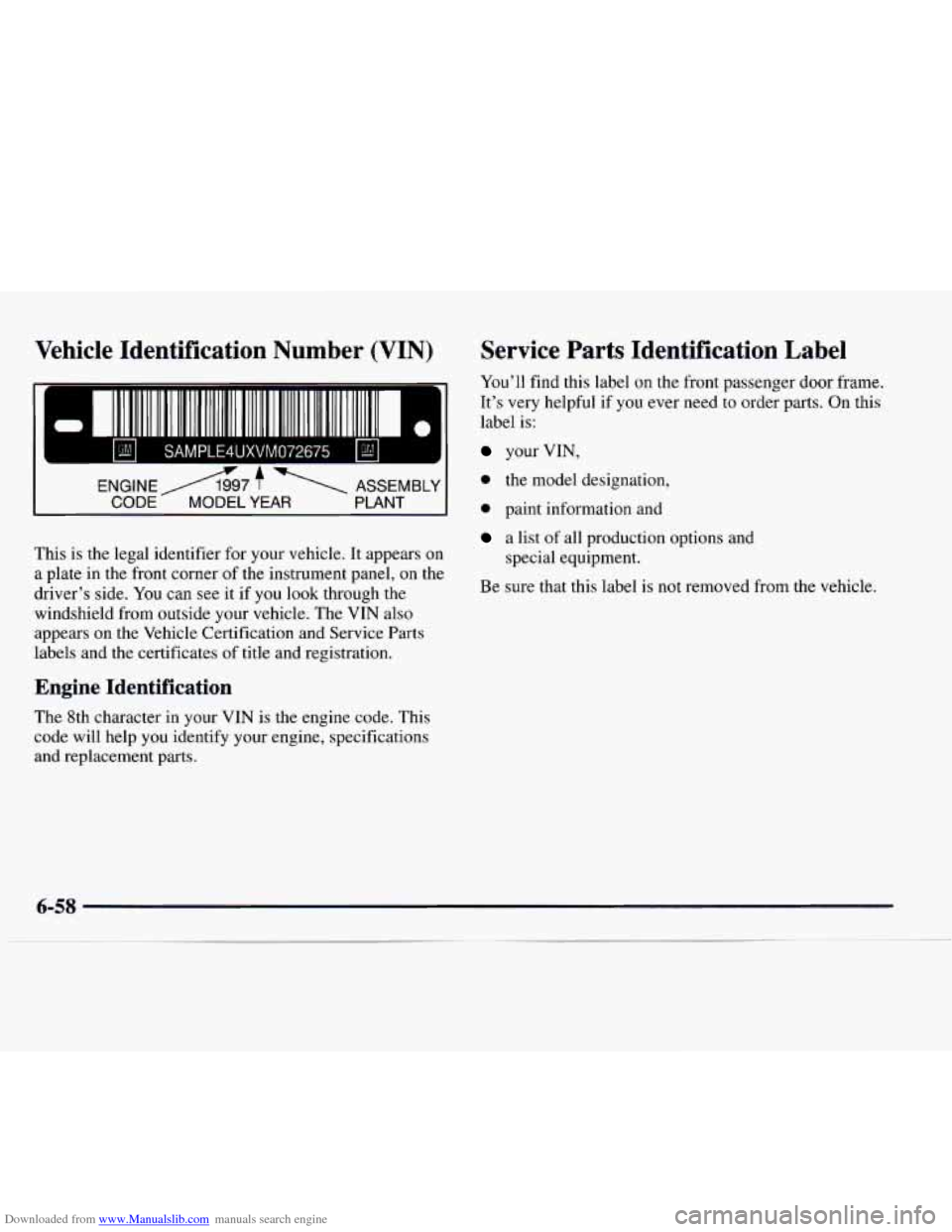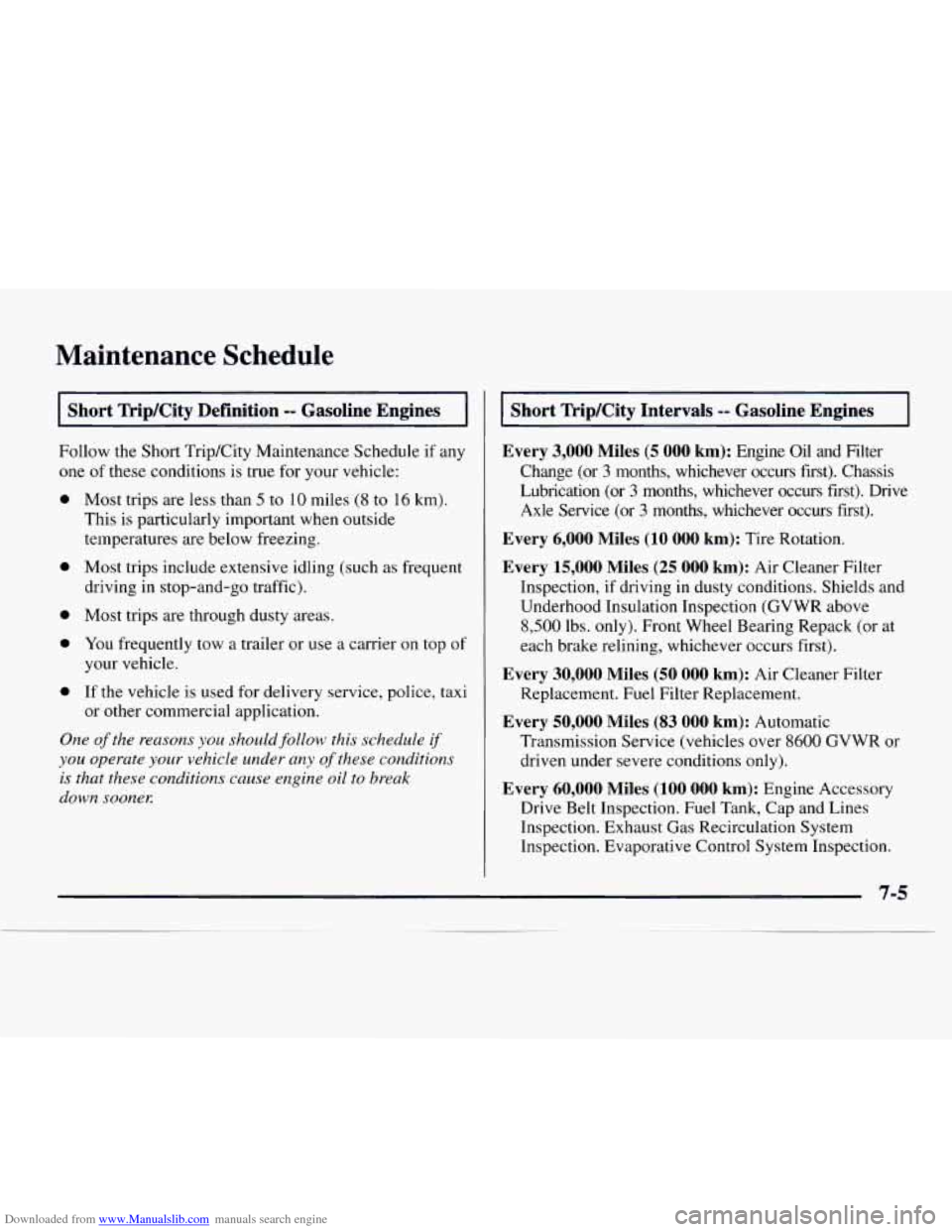Page 291 of 386

Downloaded from www.Manualslib.com manuals search engine Vehicle Identification Number (VIN)
1
I II 11111.11 1.11 111 111111 II. 1111111I 111111111111 111111111 II
SAMPLE4UXVM072675 bl
ENGlNEA97 7 ASSEMBLY
CODE MODEL YEAR PLANT
This is the legal identifier for your vehicle. It appears on
a plate in the front corner
of the instrument panel, on the
driver’s side. You can see
it if you look through the
windshield from outside your vehicle. The
VIN also
appears on the Vehicle Certification and Service Parts
labels and the certificates of title and registration.
Engine Identification
The 8th character in your VIN is the engine code. This
code will help you identify your engine, specifications
and replacement parts.
Service Parts Identification Label
You’ll find this label on the front passenger door frame.
It’s very helpful
if you ever need to order parts. On this
label
is:
your VIN,
0 the model designation,
0 paint information and
a list of all production options and
special equipment.
Be sure that this label
is not removed from the vehicle.
6-58
Page 297 of 386

Downloaded from www.Manualslib.com manuals search engine Name
RH-HIBM
ECM-I
HORN LH-HDLP
LH-HIBM
FUEL SOL
IGN-E
ECM-B
Circuits Protected
Right-hand High-beam Headlamp (Export Only)
Ignition Coil, Crankshaft Position
Sensor, VCM, Fuel Injectors,
Coil Driver
Horn Relay, Underhood Lamp(
s)
Left-hand Headlamp
(Export Only)
Left-hand High-beam Headlamp (Export Only)
PCM,
Fuel Solenoid Driver,
Engine Shutoff Solenoid
Air Conditioning Clutch Relay
Fuel Pump Relay, VCM, PCM,
Fuel Pump and Engine Oil
Pressure Switch
Capacities and Specifications
Replacement Parts
Replacement part numbers listed in this section are
based on the latest information available at the time
of
printing, and are subject to change. If a part listed in this
manual
is not the same as the part used in your vehicle
when
it was built, or if you have any questions, please
contact your
GM truck dealer.
These specifications are for information only. If you
have any questions, see the service manual for the
chassis
or refer to the body manufacturer’s publications.
Page 302 of 386
Downloaded from www.Manualslib.com manuals search engine LAMP OR BULB
INTERIOR
Dome Lamps
Reading Lamps
IP Courtesy Lamp
Stepwell Lamp
Instrument Panel Compartment Lamp
Ashtray Lamp
Sunshade Vanity Mirror
LAMP OR BULB
INSTRUMENT PANEL
Daytime Running Lamps Indicator
Charging System Indicator Lamp
Instrument Cluster Illumination
Headlamp Beam Indicator
Turn Signal Indicator
Brake Warning Indicator
SIR (Air Bag) Safety Belt Warning
Check Gages Indicator
Malfunction Indicator
("Service Engine Soon”) Lamp
TRADE NO.
211-2
21 1-2
194
194
194 194 74
TRADE NO.
74 74
194 74 74
74
74 74
74
74
3
6
2
214
1
1
4
QTY.
1
1
6
1
2
1
1
1
1
1
Page 304 of 386
Downloaded from www.Manualslib.com manuals search engine Section 7 Maintenance Schedule
This section covers the maintenance required for your vehicle. Your vehicle needs these services to retain its safety,
dependability and emission control performance.
7-2
7-4
7-5
7-5
7-6
Introduction
Part A: Scheduled Maintenance Services
Short Trip/City Definition
Short Trip/City Intervals
Long TripMighway Definition
7-7
7-45
7-49
7-5 1
7-53
Long Trip/Highway Intervals
Part
B: Owner Checks and Services
Part C: Periodic Maintenance Inspections
Part
D: Recommended Fluids and Lubricants
Part
E: Maintenance Record
Page 306 of 386

Downloaded from www.Manualslib.com manuals search engine How This Section is Organized
The remainder of this section is divided into five parts:
“Part A: Scheduled Maintenance Services” shows
what
to have done and how often. Some of these
services can be complex,
so unless you are technically
qualified and have the necessary equipment, you should
let your dealer’s service department or another qualified
service center do these jobs.
Performing maintenance work on a vehicle can
be dangerous. In trying to do some jobs, you can
be seriously injured.
Do your own maintenance
work only if you have the required know-how
and the proper tools and equipment for the job.
If you have any doubt, have a qualified
technician do the work.
If you are skilled enough to do some work on your
vehicle,
you will probably want to get the service
information GM publishes. See “Service and Owner
Publications’’
in the Index.
“Part B: Owner Checks and Services” tells you what
should be checked and when. It also explains what you
can easily do to help keep your vehicle
in good condition.
“Part C: Periodic Maintenance Inspections” explains
important inspections that your GM dealer’s service
department or another qualified service center
should perform.
“Part D: Recommended Fluids and Lubricants” lists
some products GM recommends to help keep your
vehicle properly maintained. These products, or their
equivalents, should be used whether
you do the work
yourself or have
it done.
“Part E: Maintenance Record’’ provides a place
for you to record the maintenance performed on your
vehicle. Whenever any maintenance is performed, be
sure to write it down
in this part. This will help you
determine when your next maintenance should be done.
In addition, it
is a good idea to keep your maintenance
receipts. They may be needed
to qualify your vehicle for
warranty repairs.
Page 307 of 386

Downloaded from www.Manualslib.com manuals search engine Part A: Scheduled Maintenance
Services
Using Your Maintenance ‘Schedule
We at General Motors want to help you keep your
vehicle in good working condition. But we don’t know
exactly how you’ll drive it. You may drive very short
distances only
a few times a week. Or you may drive
long distances all the time in very hot, dusty weather.
You may use your vehicle in making deliveries. Or
you may drive it to work, to do errands or in many
other ways.
Because of all the different ways people use their GM
vehicles, maintenance needs vary. You may even need
more frequent checks and replacements than you’ll find
in the schedules in this section.
So please read this
section and note how you drive.
If you have any
questions
on how to keep your vehicle in good
condition, see your
GM dealer.
This part tells you the maintenance services you should
have done and when you should schedule them. If
you
go to your dealer for your service needs, you’ll know
that GM-trained and supported service people will
perform the work using genuine GM parts. The proper fluids and lubricants
to use are listed in
Part D.
Make sure whoever services your vehicle uses these. All
parts should be replaced and all necessary repairs done
before
you or anyone else drives the vehicle.
These schedules are for vehicles that:
carry passengers and cargo within recommended
limits. You will find these limits on your vehicle’s
CertificatiodTire label. See “Loading Your Vehicle”
in the Index.
are driven on reasonable road surfaces within legal
driving limits.
use the recommended fuel. See “Fuel” in the Index.
Selecting the Right Schedule
First you’ll need to decide which of the two schedules is
right for your vehicle. Here’s how
to decide which
schedule
to follow:
Gasoline engine vehicles and diesel engine vehicles
have different maintenance requirements. If you have a
diesel engine, follow a schedule designated for diesel
engine vehicles only.
See the Diesel Engine Supplement for diesel engine
maintenance schedules.
Page 308 of 386

Downloaded from www.Manualslib.com manuals search engine Maintenance Schedule
Short TripKity Definition -- Gasoline Engines
Follow the Short Trip/City Maintenance Schedule if any
one
of these conditions is true for your vehicle:
0 Most trips are less than 5 to 10 miles (8 to 16 km).
This is particularly important when outside
temperatures are below freezing.
0 Most trips include extensive idling (such as frequent
driving in stop-and-go traffic).
0 Most trips are through dusty areas.
0 You frequently tow a trailer or use a carrier on top of
your vehicle.
or other commercial application.
0 If the vehicle is used for delivery service, police, taxi
One of the reasons you should follow this schedule if
you operate your vehicle under any of these conditions
is that these conditions cause engine oil to break
down soonel:
Short TripKity Intervals -- Gasoline Engines
Every 3,000 Miles (5 000 km): Engine Oil and Filter
Change (or
3 months, whichever occurs first). Chassis
Lubrication (or
3 months, whichever occurs first). Drive
Axle Service (or
3 months, whichever occurs first).
Every 6,000 Miles (10 000 km): Tire Rotation.
Every 15,000 Miles (25 000 km): Air Cleaner Filter
Inspection, if driving in dusty conditions. Shields and
Underhood Insulation Inspection (GVWR above
8,500 lbs. only). Front Wheel Bearing Repack (or at
each brake relining, whichever occurs first).
Every 30,000 Miles (50 000 km): Air Cleaner Filter
Replacement.
Fuel Filter Replacement.
Every 50,000 Miles (83 000 km): Automatic
Transmission Service (vehicles over
8600 GVWR or
driven under severe conditions only).
Every 60,000 Miles (100 000 km): Engine Accessory
Drive Belt Inspection. Fuel Tank, Cap and Lines
Inspection. Exhaust Gas Recirculation System
Inspection. Evaporative Control System Inspection.
Page 309 of 386
Downloaded from www.Manualslib.com manuals search engine Maintenance Schedule
I Short TripKity Intervals -- Gasom
Every 100,000 Miles (166 000 km): Spark Plug Wire
Inspection. Spark Plug Replacement. Positive
Crankcase Ventilation (PCV) Valve Inspection.
Every 150,000 Miles (240 000 km): Cooling System
These intervals only summarize maintenance services.
Be sure to-follow the complete maintenance schedule on
the following pages.
Service (or every 60 months, whichever occurs first).
I
Follow this maintenance schedule only if none of the
conditions from
the Short Trip/City Maintenance
Schedule is true.
Do not use this schedule if the vehicle
is used
for trailer towing, driven in a dusty area or used
off paved roads. Use the Short Trip/City schedule for
these conditions.
Driving a vehicle with ~l$dly warmed engine under
highway conditions causes engine
oil to break
down slower: